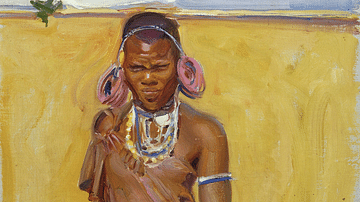
The Bantu migration from their origins in southern West Africa saw a gradual population movement sweep through the central, eastern, and southern parts of the continent starting in the mid-2nd millennium BCE and finally ending before 1500 CE. With them, the Bantu brought new technologies and skills such as cultivating high-yield crops and iron-working which produced more efficient tools and weapons.
Eventually, the Bantu dominated, with the exception of South Africa and the Namibian desert, all of the African continent south of a line crossing from southern Nigeria to Kenya. In all, some 500 languages spoken today in that vast area are derived from the Proto-Bantu language. Although most historians would agree on the general occurrence of the Bantu migrations across Africa, the precise timings, motivations, routes, and consequences are all still being debated.
The Bantu
The Bantu were agriculturalists who spoke various dialects of the Bantu language. Their heartland was the savannah and rain forest regions around the Niger River of southern West Africa (modern Nigeria, Cameroon, and Gabon). Using both stone and iron tools, they successfully grew crops such as millet, sorghum, dry rice, beans, oil palms, and melons, although they did so at a subsistence level, that is they grew only sufficient crops to meet their own needs. They had the technology to create iron from iron ore, but where this came from is not known except that the three most likely possibles are: the knowledge was introduced by the Phoenicians in the north, the Egyptians or Kushites in the east, or it was acquired locally and independently.
The Bantu people's iron tools improved agricultural yields and their iron weapons made them formidable military opponents. They were also hunters, animal herders (goats, sheep, and cattle), potters, weavers and traders, exchanging such goods as salt, copper, and iron ore for those things they needed.
Migration East & South
During the 2nd millennium BCE, small population groups of Bantu began to migrate into Central Africa and then across to the Great Lakes region of East Africa. This movement can be traced by the study of linguistics - a technique known as lexicostatistics - and observation of the relative closeness of local languages to each other and the language originally spoken by the Bantu people of the Niger River delta: Proto-Bantu. At the same time, one should be cautious with such studies as the passage of a language may not necessarily reflect the migration of its speakers. The same might be said of cultural practices and technologies.
Causes of the Bantu Migration
Historians suggest the reason for the Bantu migration may be any one or more of the following :
- exhaustion of local resources - agricultural land, grazing lands, and forests
- overpopulation
- famine
- epidemics
- increased competition for local resources
- warfare between rival tribes or as a consequence of succession disputes
- climate change affecting crops
- a spirit of adventure
It was the Bantu people who founded the coastal settlements of East Africa, what would become, with the addition of Muslim traders from Arabia and Persia from the 7th century CE, the Swahili Coast. From southern West Africa (the West Bantu) and the Great Rift Valley of East Africa (the East Bantu) two streams of Bantu peoples then moved further south in a second wave of migration which occurred during the 1st millennium BCE. A third wave of migration, in the first half of the 1st millennium CE, then took place as the East Bantu peoples moved even further south into what is today Zimbabwe, Botswana, Mozambique, and eastern South Africa.

The process of the Bantu migration has traditionally been seen by scholars as a gradual one of filtering down from village to village (and sometimes back again) through a rather sparsely populated Africa. However, the UNESCO General History of Africa puts a rather different slant on the process, at least in regards to the first wave:
The main expansion of the Bantu was vast and fast, not a series of gradual stages as some have argued. But it was a matter neither of purposeless nomadic wandering, nor of organized military conquest. It was a remarkable process of colonization - in the true sense of the word - the opening up of essentially empty lands. (Mokhtar, 320)
The Bantu shared their knowledge of iron-smelting, pottery-making, and their farming skills with indigenous forager and nomadic tribes they met, many of whom eventually then settled into stable village communities. Bantu dialects and aspects of Bantu culture were adopted, although the migrants, it is important to note, also learnt from the indigenous peoples, especially in areas like the cultivation of some grain crops or fishing techniques which had been perfected over centuries to get the best from the specific local environmental conditions. In addition, many cultural practices - the use of stone and obsidian tools, to give but one example - often continued to be used in parallel with the Bantu people's superior technologies.
Effects of the Bantu Migration
The principal consequences of the Bantu migration, then, may be summarised as:
- the spread of the Bantu and Bantu-related languages.
- the spread of iron-smelting and smithing technology.
- the spread of pottery techniques.
- the spread of agricultural tools and techniques.
- deforestation as charcoal was needed to smelt iron and metal tools made forest clearing easier.
- the spread of certain foods into new areas such as plantain bananas and yams.
- an increase in people living in villages which in turn created more distinct regional societies, kingships formed and there were further developments in technology.
- the retreat of some indigenous peoples to more remote areas.
As the peoples the Bantu came across were still in the Stone Age in terms of weapons and technology, the iron-weaponed migrants with their specialised warrior caste had little trouble imposing themselves wherever they went. Their superior technology also encouraged local peoples to accept Bantu leadership. Some groups did resist this wave of Bantu culture, such as the 'pygmies' who retreated to the depths of the central Africa rainforests or the groups of savannah hunter-gatherers, the San, who likewise retreated to the inhospitable and less accessible environment of the Kalahari Desert.






